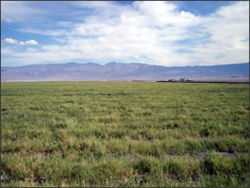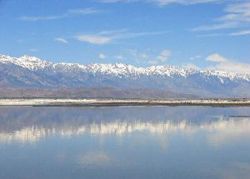User:Milton Beychok/Sandbox
The Owens Lake dry bed area at one time was characterized as being the largest single source of PM10 (particulate matter less than 10 microns in size) in the United States by the Great Basin Unified Air Pollution Control District (GBUAPCD)[1][2]. That characterization was based on an approximate, unscientific estimate made in about 1986 that the annual PM10 emissions were 300,000 tons.[3] Subsequently, the GBUAPCD monitored and scientifically tested the PM10 emissions over a long period, including daily measurements from the period of July 2000 to 2001, and determined the annual PM10 emissions were only 79,000 tons for that year-long test period.[4] That is equivalent to an average of 217 tons per day. During that test period, a single peak daily value of 7,200 tons was encountered.
During the 1980s and the early 1990s, the U.S. Environmental Protection Agency (U.S. EPA) had designated the Owens Lake area as having not attained the national air quality standards for PM10. The wind-blown sand and PM10 air pollution affected approximately 40,000 residents living near Owens Lake. Regionally the blowing sand and dust also affected U.S. Forest Service employees and the U.S. Navy's air weapons station located at nearby China Lake.[5]
The United States Environmental Protection Agency (EPA) and the United States Federal Register state that Owens Lake is in noncompliance with established air quality standards.[6][7]
Nearby residents in Keeler, California reportedly are exposed to 25 unhealthful days a year while residents in the town of Ridgecrest, California experience 10 unhealthful days per year due to the PM10 air pollution. Dr. Bruce Parker of Ridgecrest has been quoted as saying "When we see the white cloud headed down through the pass, the ER and doctors' offices fill up with people who suddenly got worse. It's a pretty straightforward cause and effect.”[1]
As of 2006, PM10 emissions and blowing dust were somewhat reduced after theLos Angeles Department of Water and Power allowed water to return to small sections of the lake and tributaries. Irrigation pipes andbubblers will help water 13 1/2 miles of lake bed. Saltgrass will also be planted to help alleviate the blowing dust and associated air pollution.[8] As of 2008, the Owens Valley Planning Area, did not attain the 24-hour National Ambient Air Quality Standards (NAAQS) for particulate matter of 10 microns or less (PM10) by December 31, 2006, as mandated by the United States Clean Air Act Amendments of 1990 (CAAA).[9] In 2009, 3.5 square miles of saltgrass have been planted. Drip irrigation is used to water the saltgrass. Ponded water or sheeting water is used to help keep the dust down. The area covered by water is 27 miles. The total amount of area covered by either grass or water is 30 miles out of the 100 mile lake bed. An additional 9 square miles of ponds or sheeting is planned as part of the Long-Term Habitat Management Plan. The Los Angeles Department of Water and Power is responsible for applying these mitigation measures which was scheduled for completion in 2010.[10]
As of December 17, 2010, the Owens Valley is classified as "Serious" by the U.S. EPA concerning the nonattainment of the NAAQS for PM10 air pollution.[11]
=========
Air quality monitoring by the District has shown that the bed of Owens Lake is the major source of PM10 emissions contributing to air quality violations in the Owens Valley Planning Area.
Studies of dust transport from Owens Lake show that the standard can be exceeded more than 50 miles away and expose many more people to violations of the PM10 standard than just the residents near Owens Lake. The dust from Owens Lake at concentrations that can be above the federal PM10 standard annually affects about 40,000 permanent residents between Ridgecrest and Bishop. In addition, many visitors spend time in the dust-impacted area to enjoy the many recreational opportunities the Eastern Sierra and high desert have to offer. Wind speeds greater than about 17 mph (7.6 m/s) have the potential to cause wind erosion from the barren lake bed. Ambient PM10 readings in the Owens Valley Planning Area are the highest measured in the country.
The City of Los Angeles, acting through its Department of Water and Power (LADWP) is responsible for installing and operating the dust control measures on Owens Lake. Water diversions by the LADWP since early in the 20th century have cut Owens Lake off from its natural sources of water and caused the saline lake bed to be exposed. Frequent winds in the Owens Valley loft the lake bed soils and cause the PM10 violations. The 1998 SIP required the LADWP to begin operation of dust control measures by the end of 2001.
LADWP (still the owner of most of the valley's water rights) to hammer out a plan to curtail the dust storms by re-flooding and planting salt-tolerant grasses on 29.8 square miles of the dry lake bed.
Beginning in the 2000, Los Angeles has shallow flooded or ponded 25 square miles of the lake bed in order to control massive dust pollution (Clean Air Act requirement). This has led to a substantial increase in the acreage of wetland habitat on Owens Lake. By 2010, Los Angeles Dept. of Water and Power will add 9 square miles more of flooding and ponding. Owens Lake appears to be a major stop-over site for shorebirds and waterfowl in the southern California interior. Each spring and fall, brine flies on the lake support thousands of shorebirds, mainly Western and Least sandpipers, and thousands of ducks utilize the wetlands (especially the impoundments along the edges). An estimated 63,000 American Avocets stop at the lake during fall (Page and Ruhlen 2002). A wintering group of 300-400 Snow Geese winters here.
- California Water Plan: Update 2009 Bulletin 160-09, Volume 3, Regional Reports, pdf page 32
The Los Angeles Owens Lake Dust Control Project currently stretches across 30 of the Lake's 100 square miles. Roughly 3.5 square miles are covered with native salt grass grown on a drip system. The remaining 27 square miles are covered with ponded water or are sheet flooded. These water-based dust control methods have re-created an Owens Lake food web for birds.
Since the initiation of shallow flooding dust control measures in 2001, the lake has become a significant migratory stopover once again. During an April 2008 "Big Day" bird counting event, 49 volunteer birders observed 112 species and a total of at least 46,650 birds--including black-bellied and snowy plovers, western and least sandpipers, long-billed curlews, and thousands of California gulls, American avocets, eared grebes, small sandpipers, and ducks, respectively--at the Owens Lake.
In fall 2008, the last phase of the dust control project began, to be completed in 2010. More than nine square miles of additional ponds and sheet flooding were built.
- Owens Lake From website of the Owens Valley Committee (OVC)
The Los Angeles Owens Lake Dust Control Project currently stretches across 30 of the lake’s 100 square miles. Roughly 3.5 square miles are covered with native salt grass grown on a drip system, and the remaining 27 square miles are covered with ponded water or are sheet flooded. These water-based dust control methods have re-created the Owens Lake food web that once again supports thousands of birds.
Beginning in fall 2008, the last phase of the dust control project will start, with completion scheduled for 2010. More than nine square miles of additional ponds and sheet flooding will be built, thereby adding additional habitat for shorebirds and waterfowl.
Recent News From Owens Lake From the website of the Owens Valley Committee (OVC). Scroll down to pdf page 5.
- ↑ Jump up to: 1.0 1.1 Survey of Reported Health Effects of Owens Lake Particulate Matter From website of the Great Basin Unified Air Pollution Control District (GBUAPCD). Retrieved on 2011-01-31.
- ↑ Note: The primary air pollution regulatory agency in the state of California is the California Air Resources Board (CARB). The GBUAPCD is one of the 35 air pollution control districts, which report to CARB and which address air pollution problems at the local level.
- ↑ Personal correspondence in an email from Mr. Ted Schade of the GBUAPCD on February 3, 2011.
- ↑ Quantifying Particulate Matter Emissions from Wind Blown Dust Using Real-time Sand Flux Measurements Duane Ono and Scott Weaver of the Great Basin Unified Air Pollution Control District, and Ken Richmond of MFG, Inc., U.S. EPA Emission Inventory Conference, San Diego, California, April 2003. From website of the U.S. EPA. Retrieved on 2011-01-31.
- ↑ Owens Valley, CA Particulate Matter Plan: History From website of the U.S. EPA. Retrieved on 2011-01-31.
- ↑ Findings of Failure To Attain; State of Arizona, Phoenix Nonattainment Area; State of California, Owens Valley Nonattainment Area; Particulate Matter of 10 Microns or Less From website of the U.S. EPA. Retrieved on 2011-01-31.
- ↑ Owens (Dry) Lake, California: A Human-Induced Dust Problem From website of the U.S. Geological Survey. Retrieved on 2011-01-31.
- ↑ New Era for Old Foes in Water Wars From website of the Los Angeles Times. Retrieved 2011-01-31
- ↑ Overview Of Great Basin Unified Air Pollution Control District Air Quality Plans From website of the Great Basin Unified Air Pollution Control District. Retrieved on 2011-01-31.
- ↑ President's Message From website of the Owens Valley Committee. Retrieved on 2011-02-02.
- ↑ Criteria Pollutant Area Summary Report From website of the U.S. EPA Green Book. Retrieved on 2011-02-02

